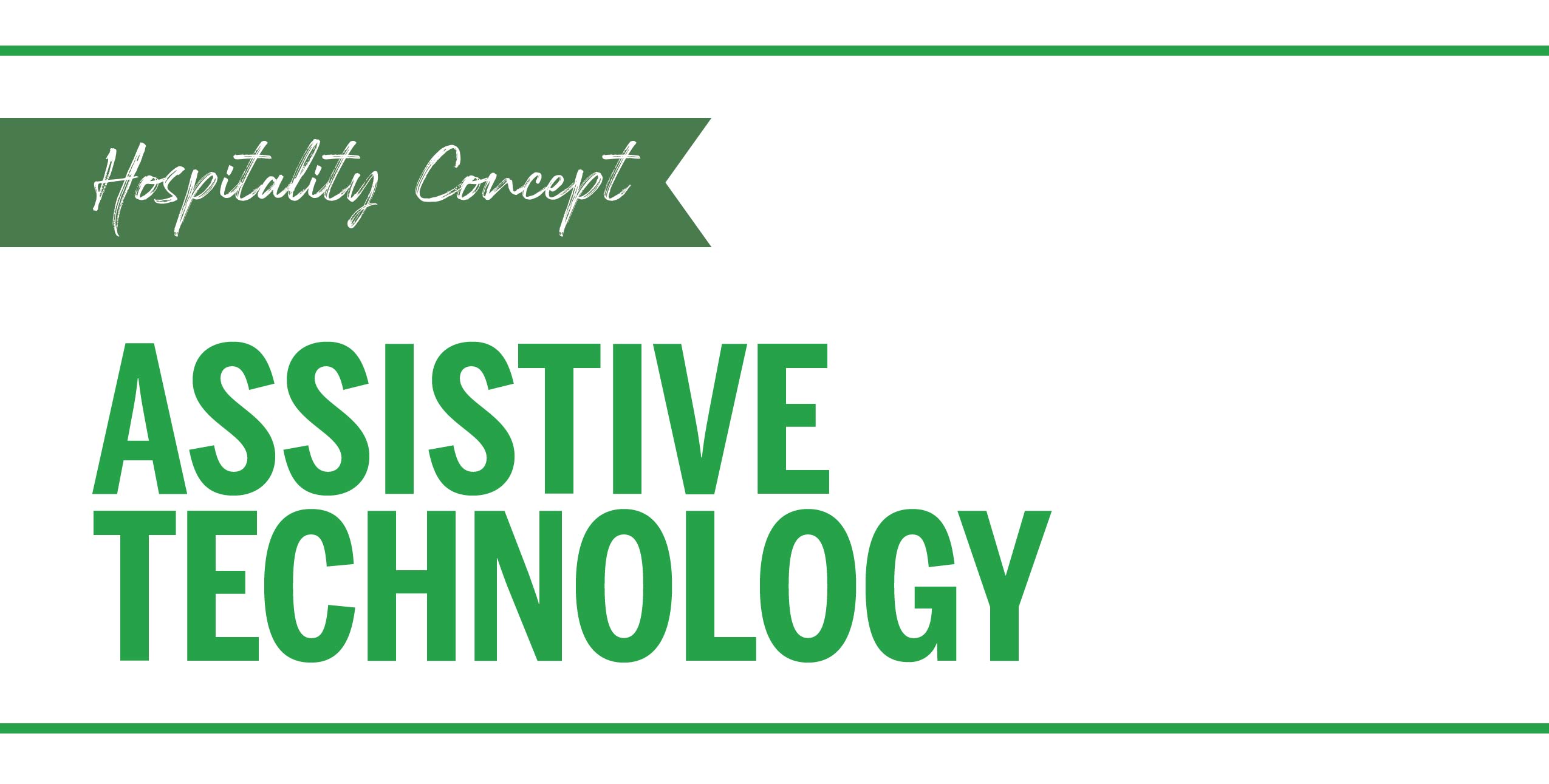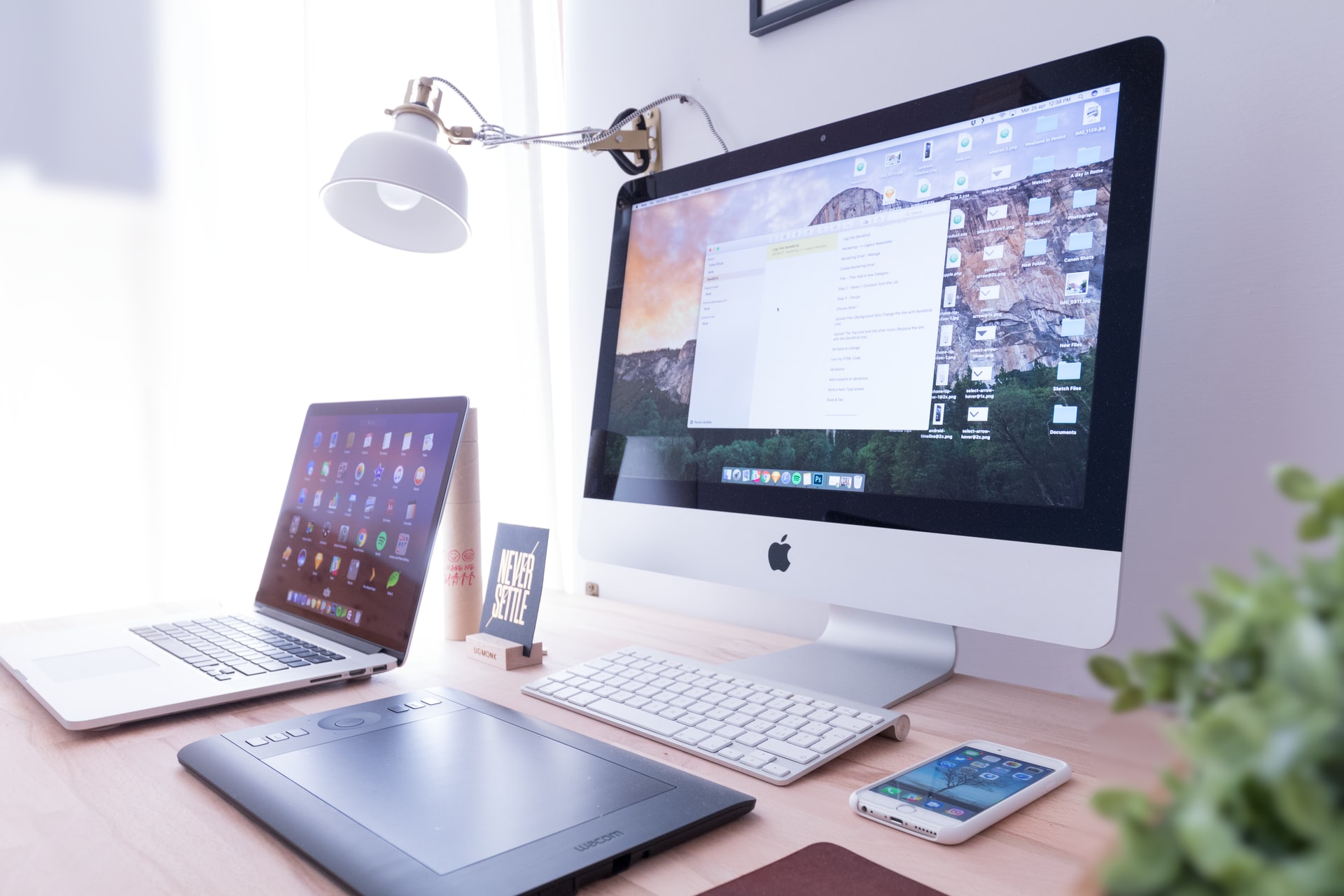13.01: Assistive Technology
- Page ID
- 11471
 This section was written by Patrice Wheeler.
This section was written by Patrice Wheeler.
Accessibility: Technology’s Role for An Inclusive and Accessible Hospitality Setting
Assistive Technology
Assistive Technology is any device or software that provides access to information and technology for persons with disabilities. These are technologies that enable someone with a disability to do something they otherwise could not do.
The Americans with Disabilities Act (ADA) is a law that makes sure that people with disabilities have the same rights and opportunities as everyone else and have access to public areas, employment, transportation, government services, and all forms of communication. The ADA is a civil rights law, so its protections are similar to those provided to individuals based on race, color, sex, national origin, age, and religion.
Technology and assistive technology are tools often used to create access to the opportunities and rights protected by the ADA.
The Role of Technology
The technology used in hospitality settings for services and providing information, coupled with the personal technology guests use, can be leveraged to provide access to those services and information.
It can be overwhelming when asked to learn about technology (especially technology you may not have a need to use) or determine which technology-based solution is the best choice for a given situation. There are some basic strategies you can use to make this task less daunting, regardless of how tech-savvy you are.
Stay person-centered. Hospitality is a guest-centered or person-centered industry, so take a person-centered approach to accessibility and consider a potential solution to an access issue. This is an interactive process that takes a 'person first, technology second’ approach that all hospitality staff can use to assist guests with disability-related access challenges.
This approach will enable you to work with the guest in identifying the task they are trying to accomplish, the challenge(s) they are having with access, and then moving forward to find a solution. Taking this approach will help you to understand how people use their assistive technology tools to interface with your space, services, and technology.
Use Scaffolding or categories to break technology down into manageable groups. This can apply to the technology used at the venue and the guest’s own technology.
One way to do this is to break technology down into 3 categories, high-tech, low-tech, or no-tech. High-tech is usually personal, mobile, and is ever-evolving, low-tech is less expensive and/or less complex, and no-tech is the least complex and requires little to no training to use or even create.
Scaffolding Assistive Tech by Patrice Wheeler is licensed under CC BY 4.0
Restaurant menus are an example of going from a no-tech solution of having a menu read to a guest or using a low-tech/no-tech menu with large print or Braille, to going high-tech by providing E-menus accessible on a tablet provided by the venue or a guest’s own phone or device.
Technology & Hospitality
The hospitality services industry includes hotels, restaurants, entertainment, sporting events, cruises, and other tourism-related services.
Persons with disabilities travel and spend a considerable amount of money on various Hospitality-related services.
-
In 2018, Hotel Business.com reported ‘travelers with disabilities spend approximately $19 billion on travel each year but must do more pre-planning than the average guest due to a lack of digital accessibility’.
-
A study by the Open Doors Organization found that ‘46% of travelers with disabilities say they’ve encountered major accessibility barriers associated with a hotel stay’.
Persons with disabilities are an ‘untapped market’ for the hospitality industry and with an aging population, and that market is expanding. Concerted and intentional efforts and policies that create welcoming, inclusive, and accessible settings are ‘good for business’.
“Accessibility will eventually affect us all. Imagine an elderly traveler with a bad hip or knee who needs to know if there is a walk-in shower in their hotel room, a wheelchair user looking to find out if the elevator doors are wide enough, a parent with a stroller who wants to know how many steps there are at the hotel entrance, or a menu in larger print for someone who forgot their eye glasses in a restaurant. That’s accessibility... (in) 20 years, 75 million Baby Boomers will be aging into disability. This demographic has amassed the largest accumulation of wealth in history and has the time and desire to travel.”
Merriam-Webster defines hospitality as, “generous and friendly treatment of visitors and guests or hospitable treatment.”
This “generous and friendly treatment” should include persons with disabilities by considering accessibility at the beginning of a project, as a part of ongoing services and processes and not as an afterthought or only when an issue or complaint arises. This conveys to the guest that inclusion in the hospitality setting is intentional.
Taking this approach will help you to understand how guests may use their own assistive technology tools to interface with your spaces, services, and technology. Let’s look at a few examples.
QR codes have been around for quite a few years. They are black and white squares, with embedded information, that can be scanned with a smartphone’s camera and an app. Once scanned, the information embedded is displayed on the guest’s phone, allowing the guest to access the information using the assistive technology on their device, and the information can be easily updated.
QR codes can be as simple as a standalone holder on a table, placed on existing signage or kiosks. QR codes are an example of leveraging technology for a better guest experience and providing access to important information for guests with disabilities.
E-menus are another example of how hospitality venues are leveraging technology. E-menus give guests the opportunity to utilize their smartphone or tablet or a device provided by the restaurant to view an enlarged menu, choose a color scheme, hear the menu read aloud, etc
Think of these examples as a beginning point in developing an awareness about the elements in various workspaces where accessibility already exists, could be expanded, or needs to be addressed.
The next step is to think proactively about accessibility in your hospitality work settings.
You may be part of a team developing or refining hospitality processes, procedures, materials, etc. Work with your team to ask questions about the accessibility of products or materials. Consider how various technologies can be a solution to a problem or issue, and always ask, “is it accessible?” This can often eliminate or reduce accessibility issues, as well as providing a better guest experience.
This is often referred to as using a design mindset. It’s like brainstorming, but with more direction and focus on a final solution, while still considering all options.

Photo by Domenico Loia on Unsplash
Career Paths
The hospitality industry is utilizing technology for almost every facet of the guest experience. This has an impact on the skills staff will either need to know starting a job or learn as part of ongoing professional development.
"The impact of technology is reshaping occupations and new job categories are beginning to appear on the market requiring hybrid skills. Not only will staff have to know how to do their traditional job as in the past, but they will also be expected to have knowledge of the technological world that is evolving around them." - Julia Aymonier, Former Chief Digital Officer (CDO) at EHL.
So even if you’re not looking for a technology career in Hospitality, you’ll likely be expected to use and learn technologies specific to your job and assist guests in using the technology as it applies to them, i.e. venue websites, kiosks, electronic signage, tech-enabled meeting spaces, etc.
This includes accommodating guests with disabilities and they may need your assistance using the guest-centered technology at your venue.
Hone your interpersonal skills to build rapport as you greet guests. Take it as an opportunity to wow them with your willingness to accommodate. Find out what their needs are, and be ready to assist them with any barriers or challenges. Utilize professional development opportunities on the job to develop your tech knowledge.
Accessibility is not only the right thing to do but creating an accessible and inclusive venue ultimately benefits everyone. Your guests will enjoy their experience, employees will feel confident and proud of the services they provide, and the company’s bottom line will reflect this success.
Resources
If you’d like more information about the technology mentioned in this chapter, check out the following links.
References
Using Tech to Help Travelers With Disabilities by Corris Little
"Hospitality", Merriam-Webster. All Rights Reserved.
Why accessibility is the hotel industry’s most overlooked asset by Stephen Cluskey
Developing Hybrid Skills: How Tech and AI are Reshaping the Hospitality Job Market by Julia Aymonier, Former Chief Digital Officer (CDO) at EHL

